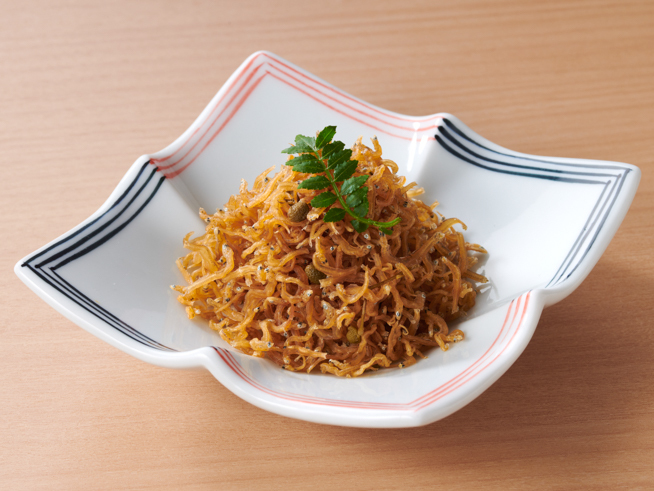
Chirimen Sansho

KyotoChirimen Sansho
Classification (Large)
Seafood products
Classification (Small)
Seasoned preserved foods
Main ingredients used
Chirimen-jako, mi-sansho, sake, soy sauce, mirin, soup stock
When using downloaded images, please read the "Terms of Use" and clearly state that the source of the image is "Traditional Foods in Japan" by the Ministry of Agriculture, Forestry and Fisheries.
If the photo credits is stated, please include it as well.
Example of description
of the photo credits
Example of description when the photo credits is not stated
Source: "Traditional Foods in Japan" Ministry of Agriculture, Forestry and Fisheries
Example of description when the photo credits is stated
Source: "Traditional Foods in Japan" Ministry of Agriculture, Forestry and Fisheries
Photo credits:xxx
Region of inheritance
Kyoto City
Product overview (special characteristics and types)
Chirimen-sansho is made by simmering chirimen-jako (boiled and dried white fish fry) and mi-sansho (green sansho fruit) in soy sauce sweetened and spiced up with sake, mirin and soup stock. It is a representative Kyoto-style small dish (known as obanzai) and is a popular souvenir to bring back from Kyoto. Chirimen-sansho is available at souvenir shops and restaurants across Kyoto City and the seasoning varies depending on the shop. It is sold under many different names, including jako-sansho and sansho-chirimen.
History and culture
In Kyoto, a city away from the sea, people did not often have the opportunity to eat fresh fish and developed the custom of processing and preserving fish in salt, miso, and soy sauce. "Chirimen-jako," called "shirasu" in the Kanto region of Japan, refers to sardine fry and other immature white fish boiled with salt and dried. The history of sansho (Japanese pepper) dates as far back as the Kojiki (The Records of Ancient Matters). It was used as medication in the Heian period, and has been used as a spice since the Muromachi period. "Mi-sansho" refers to green sansho fruits harvested in early spring. Chirimen-sansho was first created by Yasuo Harema, a cook in Miyagawa Town, in the mid Showa period, as a small gift and to share with others. His family began to sell this dish in 1971, the same year in which Yasuo Harema fell ill. Later, it gained nationwide recognition as a specialty of Kyoto.
Production method
Dry-roast chirimen-jako. Add mi-sansho, soup stock, sake, mirin, and soy sauce, and let it cook until the broth is gone.
Conservation and succession efforts
Many shops and food companies cook and sell chirimen-sansho, the taste and texture of which vary depending on the shop/company. It is also popularly made at home and many households enjoy cooking it according to their own recipes.
Main consumption method
Chirimen-sansho is popularly used to accompany rice and ochazuke (cooked rice with tea poured over it) and to spice up many different dishes. It has a wide range of applications, such as topping tofu, getting boiled with vegetables, and filling dashi maki tamago (Japanese-style rolled omelet), as well as in fried rice, salad, pasta and many other dishes.
At-home recipes:Chirimen hiyayakko
Ingredients
Chirimen-sansho
2 teaspoons
Kinugoshi (silken) tofu
1/2 cho
Oba (beefsteak plant leaves)
2 leaves
Ground white sesame seed
As needed
Sesame oil
As needed
How to make
Cut the tofu into bite-size slices.
Put the slices of tofu on a serving dish, sprinkle with chirimen-sansho, Oba (beefsteak plant leaves), and ground sesame seed, and add sesame oil as the finishing touch.

